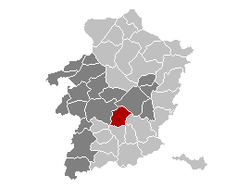Diepenbeek
| Diepenbeek | |||
|---|---|---|---|
| Municipality | |||

Diepenbeek town hall
|
|||
|
|||
| Location in Belgium | |||
| Coordinates: 50°54′N 05°24′E / 50.900°N 5.400°ECoordinates: 50°54′N 05°24′E / 50.900°N 5.400°E | |||
| Country | Belgium | ||
| Community | Flemish Community | ||
| Region | Flemish Region | ||
| Province | Limburg | ||
| Arrondissement | Hasselt | ||
| Government | |||
| • Mayor | Patrick Hermans (Puur Diepenbeek) | ||
| • Governing party/ies | Puur, Open VLD, N-VA, CD&V | ||
| Area | |||
| • Total | 41.19 km2 (15.90 sq mi) | ||
| Population (1 January 2016) | |||
| • Total | 18,906 | ||
| • Density | 460/km2 (1,200/sq mi) | ||
| Postal codes | 3590 | ||
| Area codes | 011 | ||
| Website | www.diepenbeek.be | ||
Diepenbeek (Limburgish: Diepenbik) is a municipality located in the Belgian province of Limburg near Hasselt. On January 1, 2012, Diepenbeek had a total population of 18,337. Its total area is 41.19 km² which gives a population density of 430 inhabitants per km².
The municipality includes the communities and hamlets of Bijenberg, het Crijt, Dorpheide, Keizel, Lutselus, Pampert, Piannesberg, Reitje, Rooierheide, Rozendaal, and Zwartveld.
It is home to Hasselt University, slowly expanding towards Hasselt itself. The Limburg Science Park is located on the university campus.
...
Wikipedia




